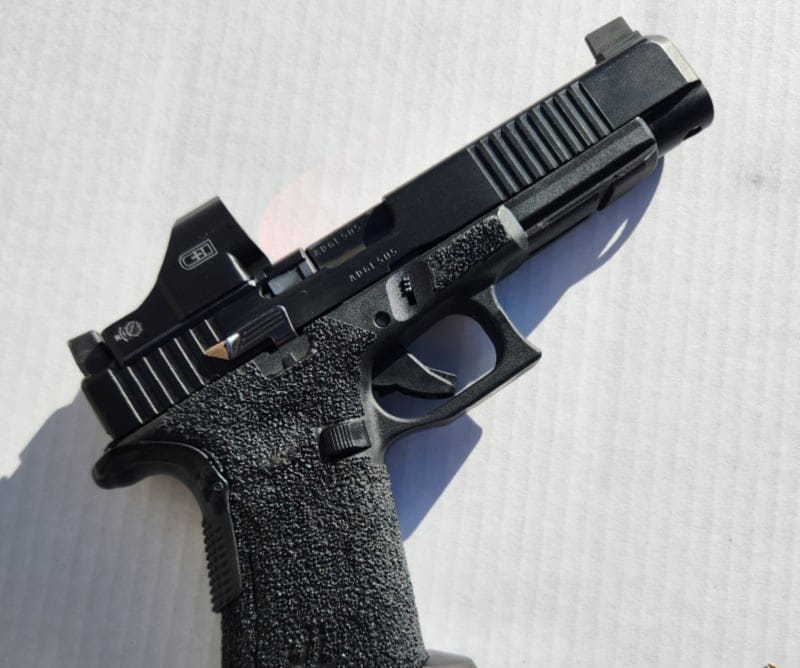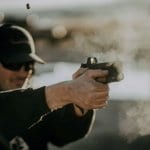I am a big proponent of pistol red dots. Because of this, I try and keep up with the new micro red dot technology coming out. At SHOT Show this year C&H Precision introduced three new optics, and they are now on the open market.
The three optics are Comp, Duty, and EDC. Each of them is designed for specific areas in the firearm industry, with the ability to overlap. Let’s go through the details of each of these three optics and my impression while using them.

C&H Precision Comp
The Comp was designed for competition. It has a larger objective window which allows the user to find the dot under the time constraints of competition, duty, or EDC. It has 10 levels of brightness, two are night vision capable with a 3 MOA dot size. The Comp has a shake-awake control, with an auto-off feature after five minutes of inactivity. With all those features it has a reported 50,000 hours of battery life. It has a CNC machined one-piece aircraft aluminum body. It’s 100% shockproof and is waterproof to one meter for 30 minutes. It sells for $485.00 and comes in either red or green dot color.

I was very excited about the Comp version, due to the larger window in its design. With a design like this, you will be able to track the dot much more aggressively. Most shooters, including me, observe the dot move higher or lower in the window under recoil. Because of the increased window size, you can follow or find the dot easier than a standard RDS would allow.
While mounting the Comp on my Gen 5, Glock 34, I observed it had no visible tooling marks, clean lines, a recessed window, and a battery compartment on the top center portion of the body. The ability to change the battery without taking the optic off the slide is a big plus. It also has a rear sight milled into the rear of the optic.
When zeroing the Comp, I noticed the elevation and windage adjustments have a noticeable click adjustment feel and audible click. Other optics on the market don’t have either and it makes the process of zeroing the optic a chore.
The Comp comes with a 3 MOA dot, which is clear and precise. I prefer a smaller dot size during the zeroing process because it allows me to attain the most precise zero.
The brightness settings are also fantastic. While using the Comp, I, went to several different shooting locations. I was able to see the dot in the bright cloud-free mid-day sun as well as in indoor shooting range conditions which are partially lit. All in all, the C and H Precision Comp is a great optic, and one I will be looking to purchase.
C&H Duty
The C&H Duty is a closed-emitter optic, meaning it is sealed by windows on each side to make it more rugged. It is CNC machined from a one-piece aircraft aluminum body. A positive about the enclosed emitter is you don’t have to worry about the dot being interrupted by dust bunnies, water, or dirt. It has a 3 MOA dot size and 10 levels of brightness, two are night vision capable. The dot intensity is adjusted by a flush up and down button. The Duty has a shake-awake control, with an auto-off feature after five minutes of inactivity. It also has a reported 50,000 hours of battery life, just like the Comp.

It’s 100% shockproof and waterproof at 1 meter for 30 minutes and sells for $378.85 to 421.95 depending on the color of the dot and or reticle. The reticle comes in red, green, or multi-reticle (3 MOA dot with 48 MOA circle).
I like the closed emitter optics for many reasons. The first reason is that walking around with a gun in a duty holster in a patrol setting helps to reduce issues an open emitter optic has. Even though current duty holsters have a hood covering the optic, water, rain, and dust, can find their way into the open emitter optic. The dot will be obscured and your ability to get a perfect sight picture will be reduced. Although the closed emitter can still have rain or dust collect on the window, it won’t hit the area where the dot projects from the optic body and interrupt the dot image on the objective lens. This interruption can cause sparkling on the objective lens, making it difficult to aim.
The body of the Duty is rugged and well-made. The battery cap is on the side of the Duty and only projects minimally above the body surface. This reduces the likelihood of those inadvertent bumps into a door jamb while completing a building search. The dot intensity buttons are flush with the Duty body for extended life. The dot intensity button on the Duty is level with the body, is large enough to easily press, and has a visible up and down arrow.
C&H EDC
The last optic in the C & H line is the EDC. This is the smallest version and is designed for EDC, duty, home defense, or range shooting. The EDC has red, green, and multi-reticle versions, and it sells for $291.95 to $347.95. The EDC has many of the same features as the Comp and Duty, including 10 brightness levels (two allowing for NVG use), shake awake feature, power management (five minutes without activity shut off), 50,000-hour battery life, a one-piece aluminum body, 100% shockproof, and waterproof to one meter for 30 minutes.
It also has a rear sight milled into the back of the optic body.
I mounted the EDC on my Glock 19 MOS using a C&H mounting plate. I like the fact the EDC is smaller with zero sharp edges to catch or scratch when drawing from concealment. Although smaller than the other options, the EDC has a good-sized window, allowing for easy presentations.

I was able to get to the range shortly after mounting the Comp, Duty, and EDC to separate Glock MOS pistols, using mounting plates from C and H. When I completed the zeroing of these optics, I started at the five-yard line and finished my zero at the 15-yard line. I was able to get a solid three-round group in the A zone of an IDPA target with all three optic and pistol combinations. Zeroing was easy due to the defined click and audible noise projected in each optics windage and elevation adjustment knobs.
While I had these optics, I shot approximately 200 rounds per optic and pistol combination. I had no issues with the dot flickering, going out, or the battery dying during that time. The optics stayed solidly mounted to the plates and pistols. I had zero shift and was able to complete several different drills with each optic and pistol combo.
I am happy to see more companies coming to the market with new and better designs, in the end, we will see more advancements with this occurring. C&H Precision is known for the quality of their mounting plates and from what I have seen in these optics, I feel they will have the same high quality as well.
Stay safe out there and keep on training! BIG BIRD out.


